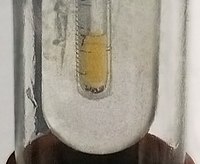
Photo from wikipedia
In recent years, anion-anion halogen bonds and neutral-anion halogen bonds have received extensive attention. In this work, the possibility of halogen bonding of neutral and anionic forms of para-substituted iodine… Click to show full abstract
In recent years, anion-anion halogen bonds and neutral-anion halogen bonds have received extensive attention. In this work, the possibility of halogen bonding of neutral and anionic forms of para-substituted iodine derivatives of dithiobenzoic acid and its Se- and Te-based congeners with halide anions has been investigated. The anion-anion complexes are not favorable in the gas phase because of the repulsive effect between anionic halogen bond donors and acceptors. A local minimum is present in the potential energy surface between the - S2 CC6 H4 I and X (X=F- , Cl- , Br- ), and the anion-anion complexes - S2 CC6 H4 I ⋅⋅⋅ X(X=F- , Cl- , Br- ) are metastable in the gas phase. Solvation is beneficial to the formation of the anion-anion complexes. The neutral-anion complexes are stable in both the gas phase and the polar solvents. The anion-anion halogen bonds tend to be stable in polar solvents, while the neutral-anion halogen bonds are stronger in the gas phase than in solvents.
Journal Title: ChemPlusChem
Year Published: 2021
Link to full text (if available)
Share on Social Media: Sign Up to like & get
recommendations!